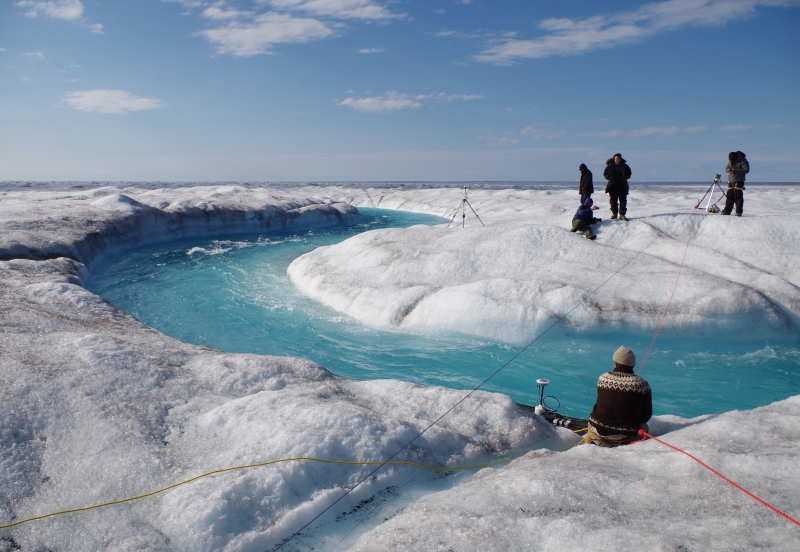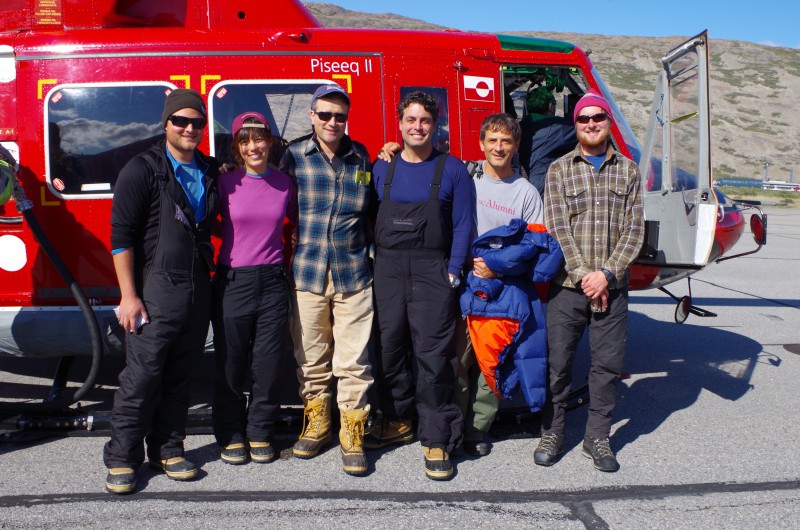
Many scientists have studied how the glaciers and big chunks of ice breaking off the edges of the Greenland ice sheet are contributing to sea level rise. Yet a new research study led by geographers at UCLA is the first to comprehensively examine how the rivers on top of the ice sheet drain meltwater and contribute to sea level rise. Importantly, the researchers found that current climate models, which do not account for subglacial processes, could be overestimating sea level rise because they do not consider the fact that a significant portion of meltwater is stored inside and below the glacier. Not all of the meltwater, in other words, immediately flows out to sea.
Both fieldwork and remote sensing were used to develop the models behind their results, which were published in PNAS, a leading science journal, earlier this week. Vena Chu, a PhD student in the UCLA Department of Geography, explained to Cryopolitics, “This is the first big study focusing on the rivers on top of the Greenland ice sheet. It brings attention to how much water is being transferred over the surface down into the ice sheet through moulins – in other words, sinkholes in the ice sheet.”
The fact that there are rivers and sinkholes on top of the ice sheet may come as a surprise to a lot of people. The ice sheet is far from a flat, white, pancake-like sheet. Dr. Laurence Smith, the lead author of the study (and my PhD advisor), instead likens it to “swiss cheese.” Through these holes in the “swiss cheese,” water flows from the top of the ice sheet and down into its inner glacial plumbing system. Chu elaborated, “We’re seeing moulins – these sinkholes – at relatively high elevations, and the water’s flowing into the interior of the ice sheet.”
The melting ice coalesces into flows ranging in size from babbling brooks to rip-roaring rivers that carve waterfalls and canyons into the ice. Most of these rivers terminate in moulins, which either drain at the front or the bottom of the ice sheet, where meltwater can be stored subglacially. The melting happens only in summer, when the ice sheet becomes a dynamic place – what Smith called the “world’s biggest water park.” Chu added, “The rivers are transporting a ton of water, and we’re not seeing any storage in lakes on top of the ice sheet for more than one season. All the lakes that we see are breached – they’re all flowing out.” Once winter comes, the top of the ice sheet freezes up again, and the sapphire rivers and lakes turn snow white.

Need for further observations
In the data that they gathered, the researchers could not account for all of the water that their models demonstrated to be melting off the ice sheet. Chu emphasized the need for more observations to back up their models. She noted, “While on the one hand, a lot of the water is moving on the ice sheet, we can’t account for all of it in the proglacial rivers. This leads us to believe some of it is being stored subglacially.” As noted, one possible implication of the team’s findings is that existing climate models may slightly overestimate sea level rise. Currently, climate models such as the Modèle Atmospherique Régional, which is incorporated in the set of models used in the United Nations Intergovernmental Panel on Climate Change (UN IPCC) reports, assumes that all of the meltwater is flowing directly into the ocean, but this may not be the case.
While the UCLA study represents a major advance in understanding the transportation and storage mechanisms of the Greenland ice sheet, the researchers still need to make a lot more observations to better calibrate the model. Plans are already underway for field campaigns and even an ice camp, where researchers live in tents on top of the ice sheet for weeks at a time, in the summers of 2015 and 2016. The findings from the next several years of fieldwork should help scientists to better understand the significant role that the Greenland ice sheet plays in global sea level rise and climate change.
Field notes (and a video) from Greenland
Since Smith is my advisor, last summer, I got the opportunity to travel to Greenland with his research team to participate in two weeks of fieldwork. During my time there, I shot some video footage, which I’ve turned into a short video. I also posted several accounts from my time in Kangerlussuaq, the town in east Greenland where we were based, and up on the ice sheet, which are under the category “Field Notes from Greenland.”
On two different days, we flew in an Air Greenland helicopter about 60 kilometers inland, looking for the ideal rivers to study and drop drifters into. Words can barely begin to justify the experience of flying a couple of hundred feet above huge waterfalls at the front of the glacier, gliding over the sharply undulating crevasse fields, and then following deadly rivers of melting turquoise upstream. It was a terrifying and sublime sight to see some of these rivers suddenly disappear into the ice through a moulin, down into the dark depths of the ancient ice sheet. One of our most memorable adventures involved flying extremely low over a river filled with white-water rapids and waterfalls – so low that the helicopter began to rattle. Some of this fly-over is captured in the video above. Our flight had a purpose, of course: we were trying to take hundreds of photographs of the river with DSLR cameras mounted on the side of the helicopter in order to map it.
Remembering Alberto Behar

The idea for sticking DSLR cameras out the side of our helicopter came from Alberto Behar, a NASA Jet Propulsion Laboratory Scientist, ASU professor, and co-author of the study. Alberto tragically passed away on January 9, and the PNAS paper is dedicated to his memory. Many of the results from the paper were found thanks to equipment specially designed for the team’s research by Alberto, who employed everything from high-tech drifters to rubber duckies to unlock the secrets of the ice. He was a father of three, scientist, engineer, and explorer with a big mind and big smile. Alberto knew how to turn up the heat when the pressure was on and how to kick back when we had a moment to relax. I worked with him in the field in Greenland this summer, and after a long cold day on the ice, I remember laughing with him when I discovered that he had found – and eaten – all of the chocolate chip cookies I thought I had secretly stashed in the back of the helicopter.
Alberto’s loss is a tremendous one for polar and space research, and we will dearly miss him as we try to carry on his legacy.

0 Comments
Landmark UCLA study reveals melting of Greenland ice sheet from top to bottom